Bird behaviors fascinate me but some of these have me stumped.
Friend and fellow bird photographer Jerry Ellison has recently been observing and photographing a nesting pair of Osprey here in northern Utah. Yesterday morning he documented some behaviors that puzzled him so he sent me these images and descriptions of what he witnessed to see if I was familiar with the behaviors. I’m not but I’m thoroughly intrigued by them.
So with Jerry’s encouragement and permission I’m posting his images and descriptions on Feathered Photography in the hope that some reader(s) may be able to provide insight into the behavior. We’re really curious to know if anyone else has seen or heard of anything like this.
In the image captions below I’ve quoted and italicized Jerry’s words to me in emails. Anything not quoted and italicized is my own. Based on the image file numbers all photos are presented in the order they were taken yesterday morning.
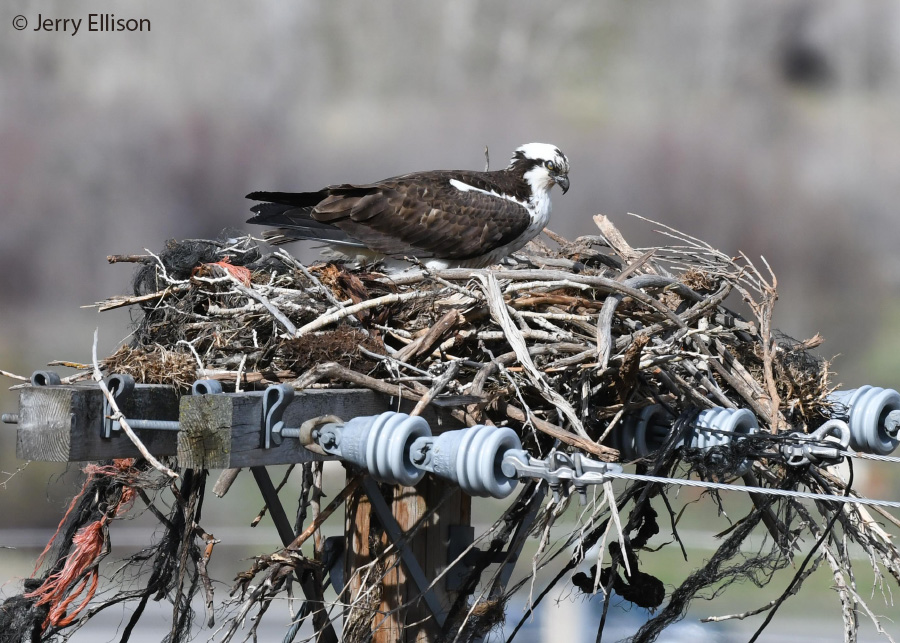
“Female fussing and arranging the nest”.
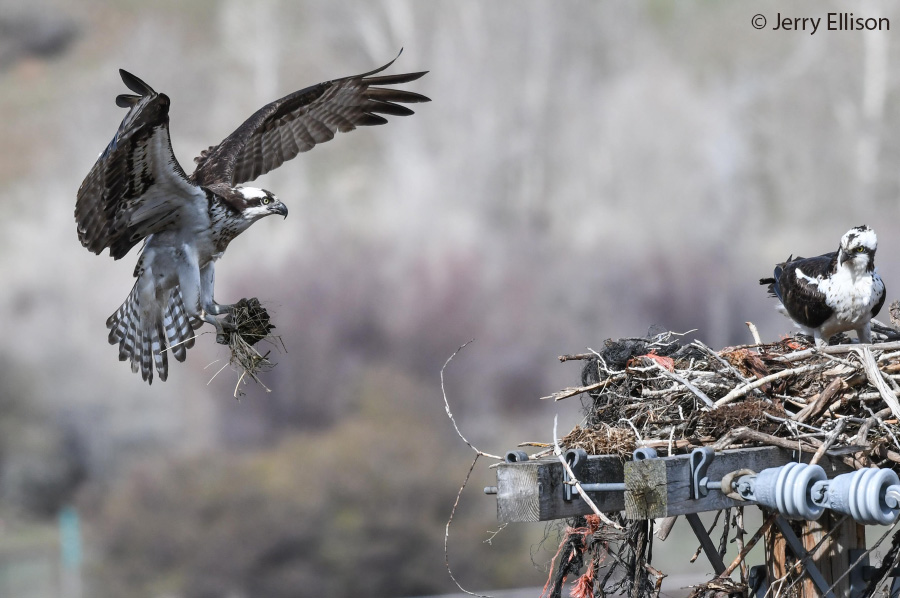
“Male returning to the nest with more nesting material”.
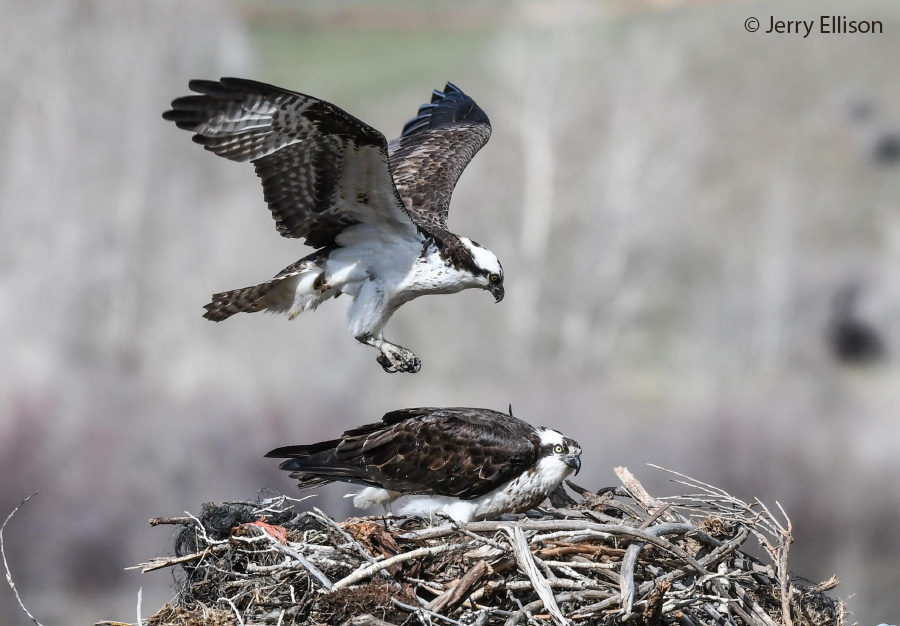
“The male then rose up in the air and came down on her left side, then rose up again and came down on her right side, then rose up again and came down on her back while thumping her back with his talons…almost like running in place”. This image (and the following one) illustrate what Jerry described.
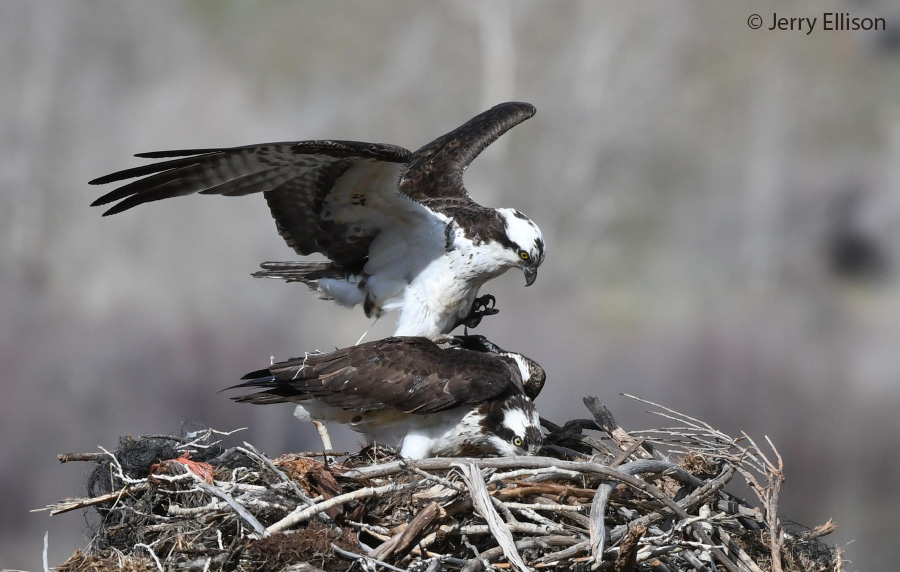
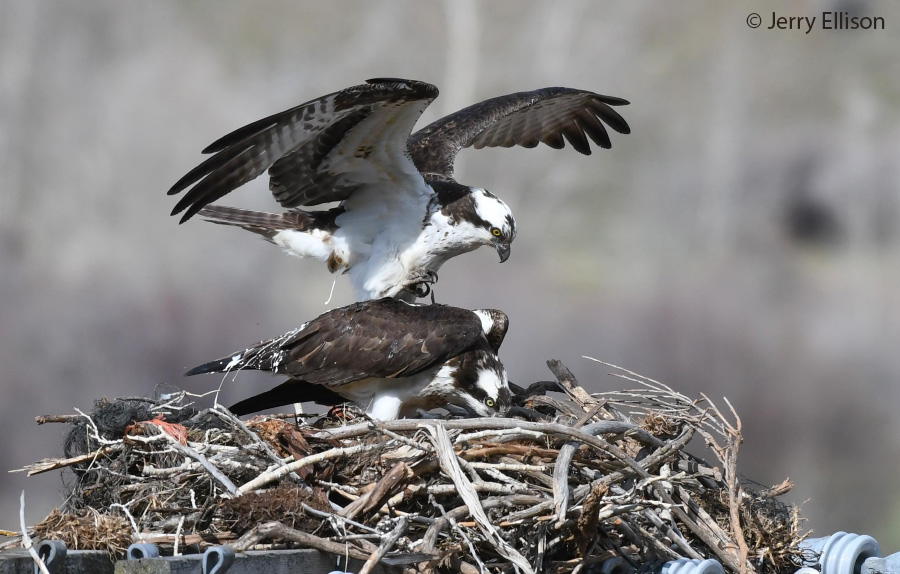
Then “he defecated all over her back and tail for about 5 seconds”…
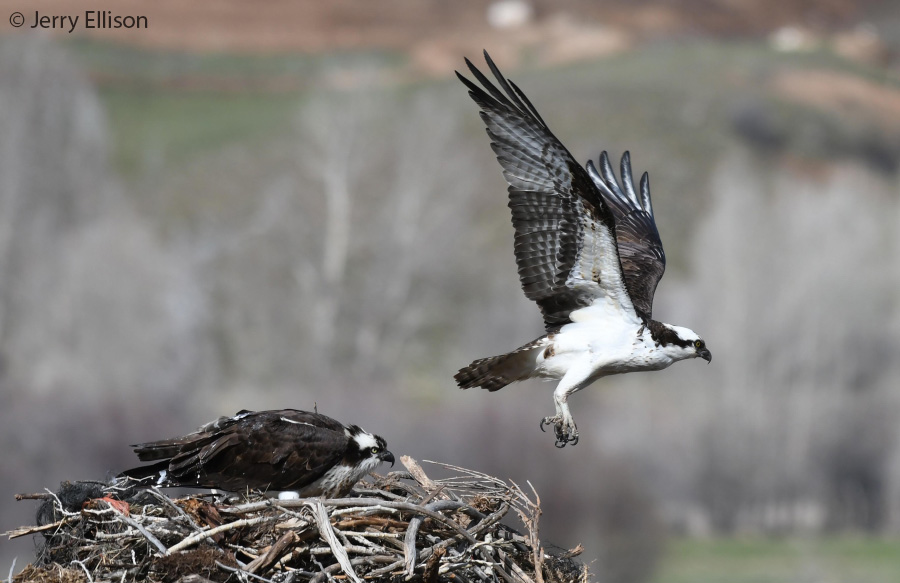
“and then flew away”…
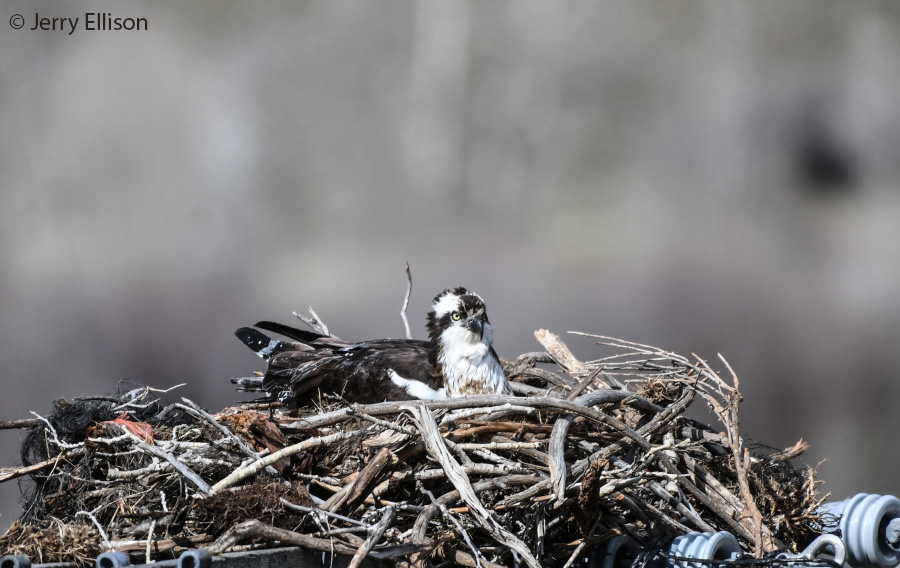
“leaving her to sit on the eggs”.
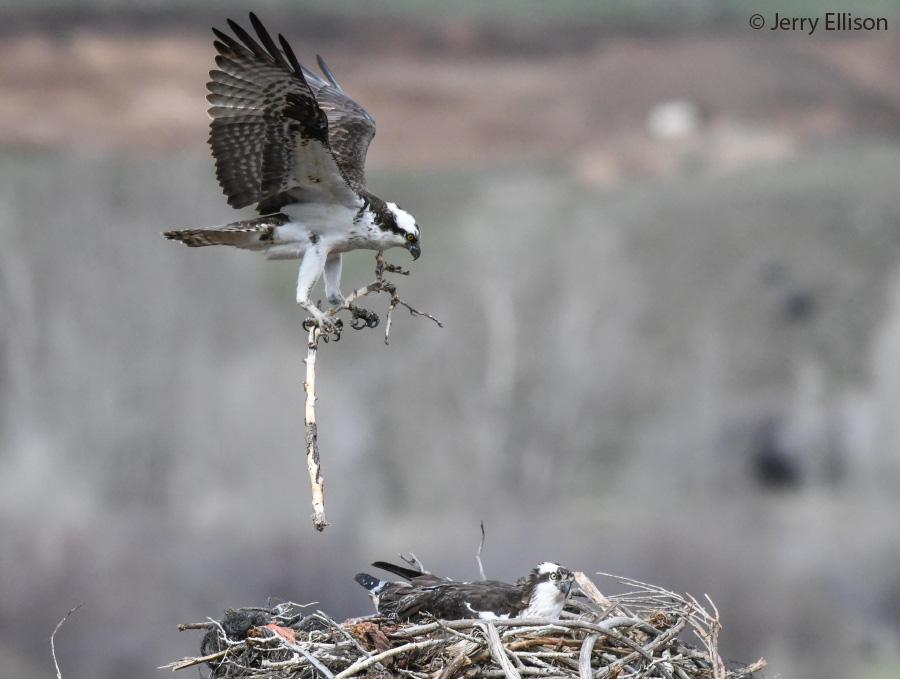
Then the male “returned with more nest material”…
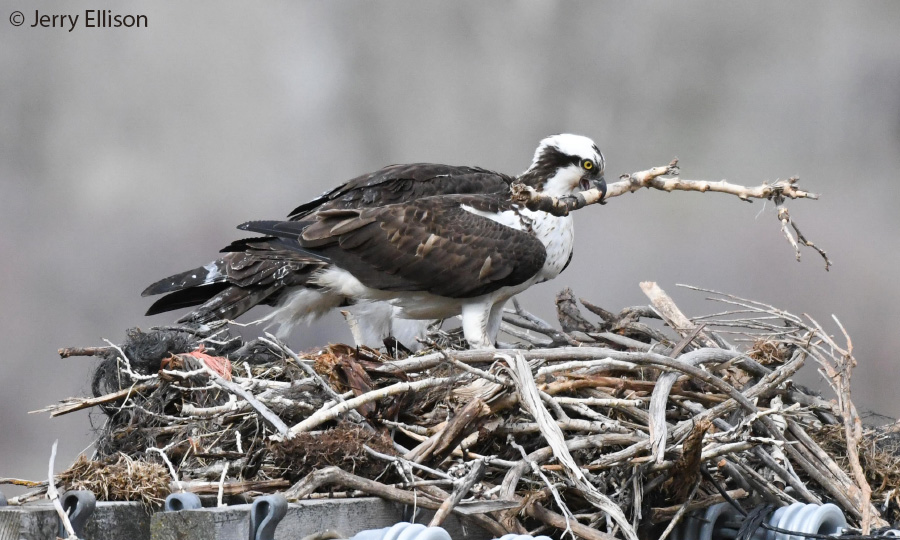
and they continued to work on the nest as if nothing unusual had occurred.
Two things about this encounter have us puzzled – the male thumping the female on her back with his feet (“almost like running in place“) and the obviously deliberate defecation of the male on the female’s back. Jerry is virtually certain that the birds did not copulate or even attempt to copulate during the encounter.
Over the years I’ve spent a fair amount of time watching the breeding behaviors of Osprey and both behaviors are new to me so I researched Birds of North America Online and found no mention of either behavior even though they describe Osprey breeding and nesting behaviors in some detail. An internet search also came up empty (though it may be that I just didn’t use the right key words in my search).
Jerry and I would both appreciate any insight into these behaviors. Thank you in advance for any feedback.
And thanks to Jerry for providing the images and descriptions.
Ron


FYI, in the first two photos it is the male on the nest and the female returning with nesting material.
Look at the neck patterns, and you will see they are reversed from the following images.
Laura Culley forwarded this to me because I have been watching osprey cams for many years now, starting with the nests in MT. Mating does not always go as planned and it is not a lesson learned from the parent’s behavior in the nest. Hal at Dunrovin has landed backwards on Harriett in an attempt to mate, immortalized by a tweet, “Wrong way Hal!” When a young male arrives at a nest with an experienced female osprey, a comedy routine may result until and if successful mating eventually occurs. Long time mated pairs, Iris and Stanley at Hellgate, Ricky and Lucy in Florida, Sandy and Pete in Idaho, Rachel and Steve at Hog Island for example easily have success in mating.
Regarding the defecation, that too seems to be a sign of a young male not sure which to do or just doing it because he just had to go! We think we know raptor behavior but we really don’t. As Laura Culley taught us cam viewers, these birds have been doing this for Eons!
Pat, that makes the most sense to me and absolutely rings true. I’ve obviously been hanging out with mature birds way too long. That didn’t even cross my mind, despite that I now remember just how goofy and clueless first-year raptors can be! Again, in a case of we’re way more alike than we are different, the young ones can really be dorks sometimes until they figure things out for themselves, mostly through trial and error. YAY for you!
“the young ones can really be dorks sometimes”
Laura, I remember well going through that stage myself. In fact it could be argued that I’ve never left it…
Yeah, I get that Ron…we all have those moments when our bulbs dim to a flicker 🙂
Thank you for your experienced insight, Pat. If we only knew for sure. I always want absolutes but nature often doesn’t provide them. Part of her charm, methinks…
Ron, if you are looking for absolutes, you will be spending all your time doing so! Absolutes, “never” and seeing only black or white don’t exist in raptor land or in human experience. Come on into the relaxing gray area!
Pat, it’s my nature to look for absolutes if/when they exist and that’s unlikely to change. But yearning for them doesn’t mean that I don’t realize that they seldom exist in nature.
I wish the “gray area” was as relaxing for me as it apparently is for you. I want answers! 🙂
Maybe the gray area is relaxing to me because it means that I don’t have to be right or search for fairness in this world. Perhaps it comes with age. The sharp edges are gone and I don’t miss them.
We humans survive and move on as best we can, and the raptors follow instinct and behavior they have had for EONS! I think I would like to come back as an osprey!
I’ve enjoyed our chat.
These look like very young Osprey. I watch about 4 Osprey cams and I noticed that the younger males are very awkward and often miss their target. For some reason osprey males seem to fly in and land on the females back and they miss the target many times.I think this is what happened here. They are so fun to watch and see them mature. The nest that was mentioned in Montana, this will be the first time the male will be a father. We watched all last year while the female taught him how to sit on a dud egg and never leave it for too long.The dud egg finally exploded but he learned a lot and is doing better this year. I think this guy was ready to go and missed his mark. She didn’t look too happy either.
Thanks for your thoughts on this, Debbie.
Regarding “dud” eggs, given my last name I’d expect that egg to hatch into a superbird! 🙂
I think Lysa is on to something here. That is, the male had a biological duty or drive to fertilize the female; it wasn’t optimal timing for the female (she had eggs to worry about) and the defecation was just coincidental. The behavior certainly seems to fit that explanation. In science it seems that sometimes the simplest explanation is the correct explanation. Great discussion, thanks to you and Jerry for posting.
Could be, Dennis. Wish I knew for sure but maybe this’ll be one of those continuing mysteries…
Wow! I’m truly overwhelmed. I’m relatively new at the art of photography, about 10 years but I’ve loved nature all my life. I was very lucky to witness and photograph a very unusual event and I have enjoyed all the comments and response. My thanks to you all, especially Ron for sharing. I’ve laughed and learned allot!
Thanks to you for taking the photos and allowing them to be shared, Jerry.
Jerry, thanks so MUCH for sharing your photos. I’m gobsmacked by folks who can take quality photos/images, especially since I struggle with a decent snapshot with an automagic camera! But you folks who are out there with the right equipment and the knowledge/skill to use it are just the best! Thanks so much for giving us this window into osprey behavior, somewhat weird though it might be–no especially because this behavior is somewhat (or more) weird!
I feel I should sign myself ‘clueless in Canberra’. Definitely intriguing. And yes, as others have said, he would have brought his last nesting material to me…
You’re never clueless, EC…
The end of your comment brought a smile.
What did Jerry Liguori have to say about this?
I haven’t asked Jerry about it, Patty. I hate to keep bothering him but maybe I will if we don’t get to the bottom of it here.
One of my brothers-in-law treated my sister like that! He ‘s ancient history, thank goodness….
🙂
Perhaps just a young male that got his “hoses” and “valves” mixed up? Kidding aside, I have observed the males doing this “running in place” movement before. It’s just my opinion, but maybe he is doing this to push her wings farther apart to make mating easier for him.
I wonder if he was even TRYING to mate, Kathy. He was never really in a position to accomplish it – too far forward on her back. Maybe he’s just young and inexperienced…
Young and inexperienced would also explain a lot 🙂
In my reading about the avian digestive tract, I find that the current thinking is that birds have no sphincters and hence little to no control over defecation. It’s interesting, for example, that owls and falcons drop their urates and fecal matter straight down, while hawks can aim and “slice.” So they must feel some activity down there before letting go. But a deliberate evacuation? If what I’ve been reading is correct, that would not be possible. Or only to a very limited degree. So while the act seems hostile or intimidating, it probably wasn’t.
“birds have no sphincters and hence little to no control over defecation”
Interesting, Sally. But I’m not sure how to square that with something I observe in the field – that buteos in particular often (very often) deliberately defecate just before takeoff. To me that strongly implies good control over defecation.
I’m very surprised to hear that birds apparently have no sphincters. That normally roundly-puckered and tightly closed cloacal opening sure looks like it’s controlled by a sphincter to me. I’m not disputing what you said but I’m now curious enough about it to do a little research…
Well, Ron, I could certainly be wrong. And I too have noticed that even captive birds defecate when the handler approaches.
Sally, I found conclusive scientific proof to support my position. See the link below… 🙂
http://bizarro.com/comics/september-17-2013/
I think you’ll find that birds have no bladder or storage unit for fecal matter, and no sphincter at the mouth of the kidney. Yes, they have a muscle at the cloaca, but no toll-keepers at the gate above. The kidney simply drains into the ureter and the urine mixes somewhere along the way with liquid-like fecal matter. And down it goes. The mixture might wait a bit at the cloaca, but as there is no storage facility, it won’t wait long. That would let a bird get just a bit “pissy” if he was annoyed, but not much!
That’s correct, Sally. I used to teach about the cloaca in my classes. Cloaca literally means “common sewer”, for obvious reasons. Besides digestive and nitrogenous wastes, reproductive products (sperm and eggs) also pass out the cloaca.
And it’s my understanding that one of the functions of the cloaca is temporary storage of wastes.
I had two non-releasable female red-tails housed together for years. They would both lay (obviously infertile) eggs and take turns incubating (sometimes would both try to sit on them at the same time) and they would, as Ezra and Big Red did, per Laura, feed each other small bits. Sometimes handing the same bit back and forth a few times. Clearly NOT like a male bringing in a large food item to the nest, but more like feeding a baby – small bits handed directly to the beak of the other bird. Maybe an excess of parenting instinct? From a human standpoint, it was very endearing to watch.
“From a human standpoint, it was very endearing to watch”.
I can only imagine, Louise. I could watch the behavior you describe for hours…
Great photo capture of very interesting behavior. I am looking forward to responses. I have seen a redtail male thump its mate similarly but it was more of a balance issue.
I’ve seen raptors of several species have similar balance issues during mating, April. I think it comes with the territory.
Hello Ron,
I am certainly no expert but I have watched an Osprey nest in MT for the last 4 years at Dunrovin Ranch. The female there, Harriet, has a new male partner these last 2 years (Hal) and he often lands right on Harriet’s back and simply sits there for as long as Harriet will allow it. Sometimes he will do the thumping on her back and we (everyone in chat there) have all speculated that he may have intentions to mate, but Harriet remains down with her tail down, so he just walks on her back for a bit and takes off or steps off to the side. This seems like new behavior to us as the original male (Ozzie) never did this. With respect to the male defecating on the female, my guess is it was just bad timing, he had to go and went!
Thanks for posting such wonderful pictures.
Interesting behavior you describe, Lysa. Thanks for telling us about it.
Won’t mention any names, but I’ve run into some humans with really weird behaviors at times. Just no telling how some express their desires. I feel like we’re peeping through a keyhole. How very odd!
I think I’ve known some of those folks you mention, Mikal…
Is it possible that the male defecated because…well, just because the urge hit him? I guess we sometimes assume that birds deliberately defecate in circumstances that won’t soil their nest or immediate surroundings, but maybe that’s not always the case. Humans learn to control their defecation for what we consider to be practical reasons, but maybe birds never really learn that control. Do we really think that a bird would react to the urge to defecate by thinking to itself: “wait, I shouldn’t do it here, I’ll hold it in until I’m in a more appropriate location” ?? Maybe the activity–the “running in place”–triggered the need, and he just happened to let loose when the female was in the way.
An interesting possibility, Jeff. Thanks for contributing.
Ron, back some years ago I was monitoring an Osprey pair in Maine. I saw the male on top of the female, both in copulation and non-copulation situations. In non-copulation behavior he would move up and down with clenched talons a few times. Did not see defecation and could not see if eggs had been laid. She did set down on the nest as if she was incubating and the male did bring sticks to the nest. I felt the male was simply reinforcing pair bond; also there was no competition from other Ospreys. Behavior between mated pairs of a species can vary. To make specific behavioral characteristics for this species based on these photos is tough. Hope you and Jerry find some answers.
Tell Jerry, he took some good shots.
“Behavior between mated pairs of a species can vary”
Boy, that’s for sure, Dick. Makes it difficult to draw any broad conclusions, doesn’t it?
Hi Ron, I love a mystery. A little research online yielded possible clues…. I saw a video of a male settling on the back of a female with feet balled up (evidently the common practice to prevent injury from talons) the male seemed to exhibit the running in place motion for a short while, gaining stability. The defecation is just a guess on my part; do you think this might have anything to do with “marking” the female to assure paternity? I read that extra copulations occurred after egg laying. Just my guess, but as I said I love a mystery!
“do you think this might have anything to do with “marking” the female to assure paternity?”
I’m not sure, Victoria but I’d guess not, partly because my attempt at researching the behavior has come up empty – with Ospreys or any other raptors for that matter. If this was common or known behavior it seems to me that I’d find mention of it in some of the places I’ve been looking.
But who knows, certainly not me…
Nope, not a clue. That said, in watching these nest cams up close over time, we’re learning a lot of things about raptor behavior that you won’t find in the books/websites, and some of it is far out of our expectations (although not THAT far out). If you don’t mind, I’ll forward this on to several of the folks who have paid more attention to the ospreys to see if they have any input, however, I’m guessing they won’t have seen this behavior, either. If they had, I’d have heard about it from them. Still…
On another note, we’re seeing some weird behavior on the Cornell redtail hawk nest, too. Big Red has been eating on the nest and even feeding morsels to Ezra when he’s brooding the eyases! We haven’t seen THAT before! And while it’s not as weird as that male osprey slicing on the female (that’s really weird), it’s still weird!
I’ll pass this along and THANKS so much to Jerry Ellison for capturing this behavior! So much happens that few of us get to see.
Share away, Laura. I’d really like to know what others who have spent a lot of time observing Ospreys might think.
No clue about the truly strange behaviors, but if I were her I’d want a divorce! I’m also now very curious.
“if I were her I’d want a divorce”
That made me smile, Susan!
Rocky! Ypu’re back!!! 🙂
Weird behavior. I have seen the jumping up and down, back and forth over the female once in Northern New Mexico. The male however did not land or touch the female and there were only a few slow jumps / hovers. I think what I saw was simply repositioning in the nest. It would be interesting to know if she had already laid eggs or not? Thanks Jerry and Ron for the photos and information. Very interesting. ( BNA is very good, however they have not seen / documented everything )
“It would be interesting to know if she had already laid eggs or not?”
Ed, Jerry seems to think that they had but I’m not positive he knows that for sure.
Ron, I have NO idea why the male would do this strange behavior but then I’m very new to raptors and most of my viewing have been eagles. Jerry might want to contact the Osprey cam sites which are on 24/7 to see if any of those sites have ever seen this behavior. One of the things that hasn’t seem to have “caught on” with the groups like Birds of America is that they don’t seem to accept info from photographers and the cams that document bird behaviors. I remember you telling us of info you have shared regarding bird behaviors that a group like Birds of America never add to their info on a particular bird. Jerry might also want to check with some of the Facebook pages that take postings on raptors or Ospreys in particular to see if any other photographers have seen this behavior. Please let Jerry know that I thought his series of photos of this pair were terrific – even the “aim & shoot” photo!!
“Please let Jerry know that I thought his series of photos of this pair were terrific”
Jo Ann, I’m confident that Jerry will get the message because I suspect he’ll be reading these comments.
“Weird” – Have NO idea – perhaps taking ownership of the female – thanks to both you and Jerry for sharing – I’m curious now also! 🙂
Thank you, Judy. Something like this really raises the curiosity levels, doesn’t it?